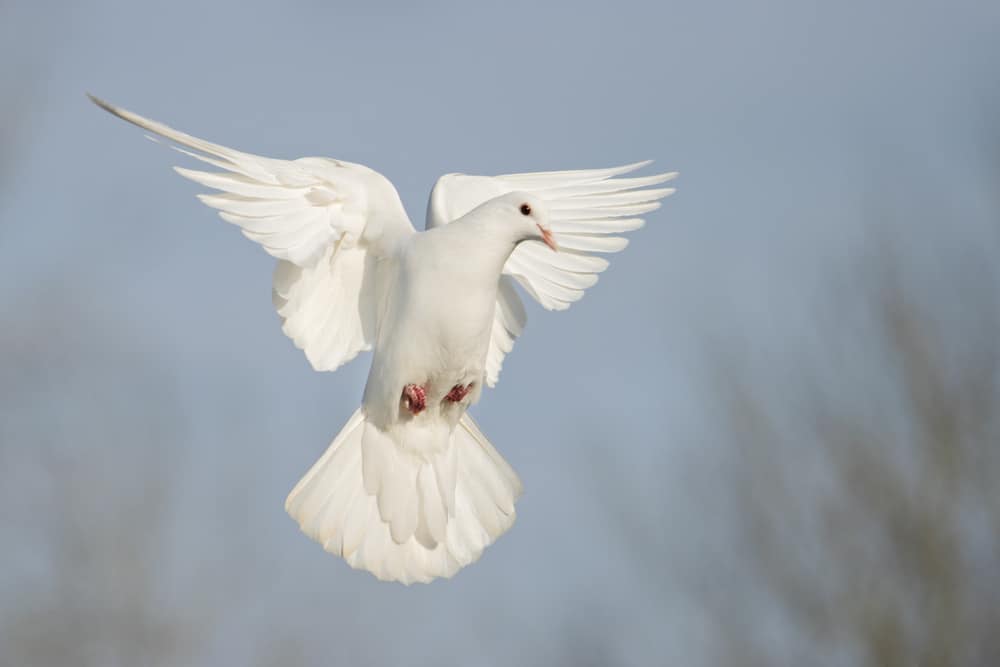Both doves and pigeons share the same city skies. You will find them flying around tall buildings, sitting on street lights, and nesting in abandoned chimneys. These birds are very easy to spot.
But have you ever wondered what’s the difference between a dove and a pigeon? They both look very similar – in fact, most people can’t tell apart a white pigeon from a white dove.
What’s even more surprising is that these birds belong to the same family!
So, why do they have separate names? Well, in today’s post, we will do a detailed dove vs. pigeon comparison to explain exactly why these birds are so different. Let’s dive in!
What is Pigeon?
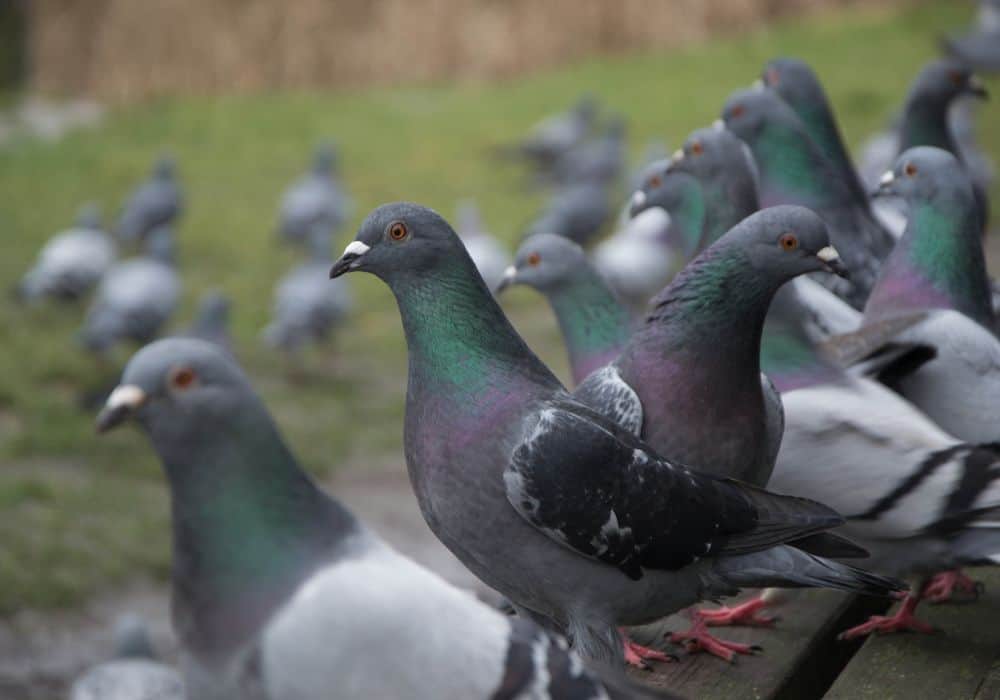
Pigeons are medium-sized birds that belong to the family Columbidae. They have stout bodies with short necks and can be found in a variety of colors. They are commonly known for their strong and swift flight.
These birds have been domesticated and used by humans for various purposes throughout history. In fact, the world’s oldest domestic bird is the domestic pigeon. This subspecies was derived from the wild rock pigeon around 5,000 to 6,000 years ago.
Back then, people had newly discovered the art of breeding. They built dovecotes to allow wild rock pigeons an alternative place to stay and breed. This increased production and provided a steady supply of pigeons to the settlers.
The pigeons that kept breeding inside these dovecotes are what we call domestic pigeons. And the ones that escaped dovecotes to breed elsewhere are called feral or wild pigeons.
Unlike wild rock pigeons and domestic pigeons, feral pigeons have a variety of patterns on their plumage. Here’s how these subspecies differ in looks:
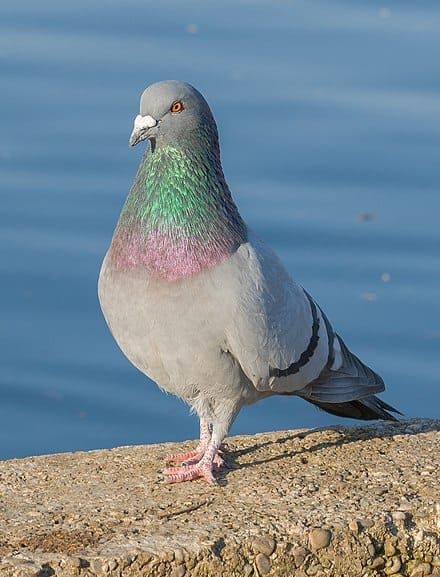
Image Credit: Wikipedia
A wild rock pigeon and a domestic pigeon look exactly the same.
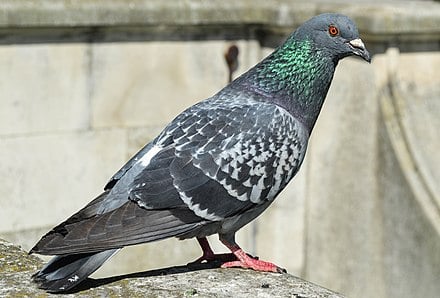
A feral pigeon has different speckled patterns all over its body.
Today, all of these 3 subspecies are commonly found in urban areas. They have adapted to human environments and are known for their distinctive cooing sounds.
However, they are no longer used for their meat or homing abilities (messengers). They were popular in sports and racing competitions, but even that has experienced a decline due to animal welfare concerns.
Although they are still appreciated by some, most people view them as pests due to their droppings and the potential damage they can cause to buildings.
What is Dove?
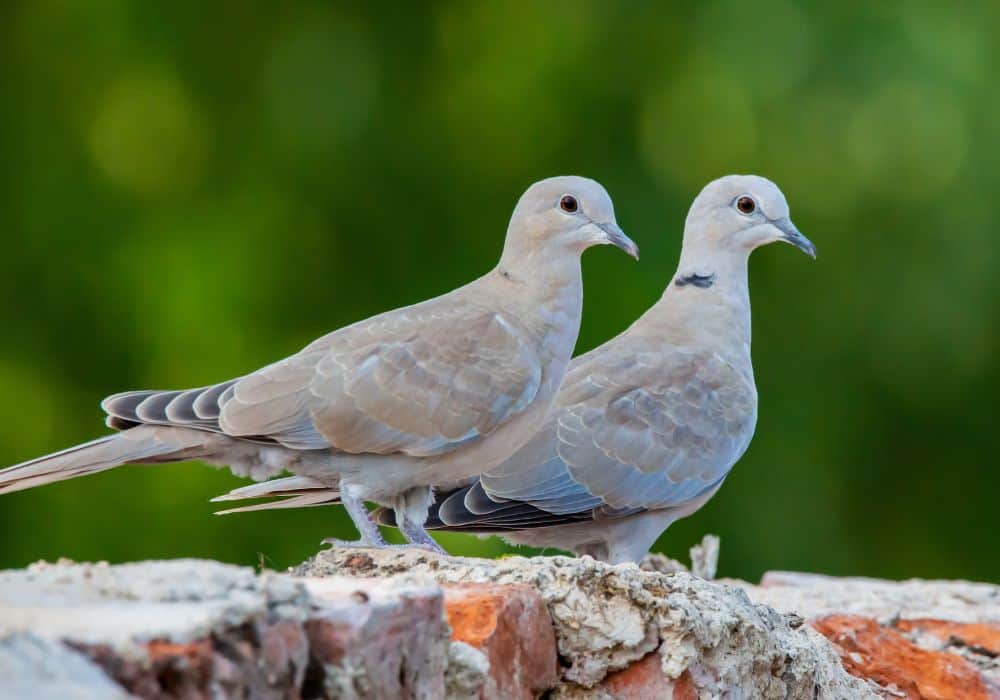
Doves also belong to the family Columbidae, just like pigeons. In fact, all doves are essentially pigeons. But the term “dove” is often used to refer to the smaller, more delicate-looking pigeons – particularly those of the genus Streptopelia.
These birds generally have slender bodies, longer tails, and softer cooing sounds. They are often associated with symbols of peace, love, and purity, and their gentle demeanor has made them beloved birds across various cultures and religions.
One of the most well-known dove species is the European or common wood pigeon (Columba palumbus). This bird is commonly seen in Europe and parts of Asia and is often referred to as a “wood pigeon” rather than a “dove.”
However, the most iconic dove species associated with peace is the Eurasian collared dove (Streptopelia Decaocto). It has a distinct black “collar” on its neck and has expanded its range greatly due to human influence.
So, although it is native to Europe and Asia, it is now found in many parts of the world. You can find this type of dove in the United States, Mexico, and even North America. The only places they aren’t found include the high Arctic and Antarctica.
That being said, doves aren’t as common in cities as pigeons. They usually settle down in woodlands, suburban, and rural places where greenery is abundant. When in the city, they like to stay away from the hustle and bustle.
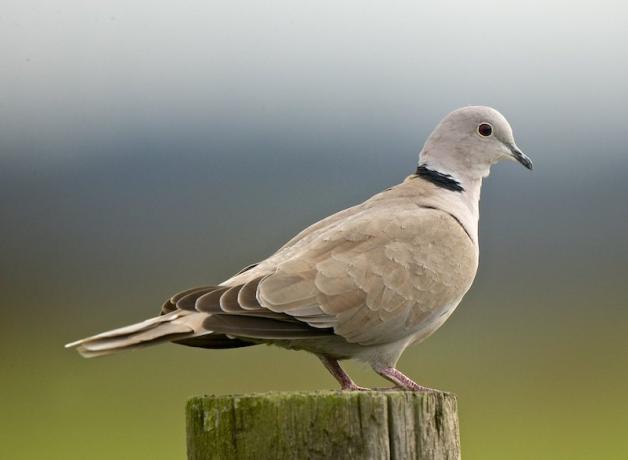
Image Credit: birdnote
Eurasian Collared Dove
Pigeon vs. Dove: Key Differences Explained
Now that we have discussed what these two birds are. Let’s have a look at their differences in detail!
1. Appearance
At a glance, you can’t really distinguish between a pigeon and a dove. They both belong to the same family and have very similar physical characteristics. But if you look closely, you’ll see that a pigeon is bigger and bulkier than a dove.
Have a look at this picture:
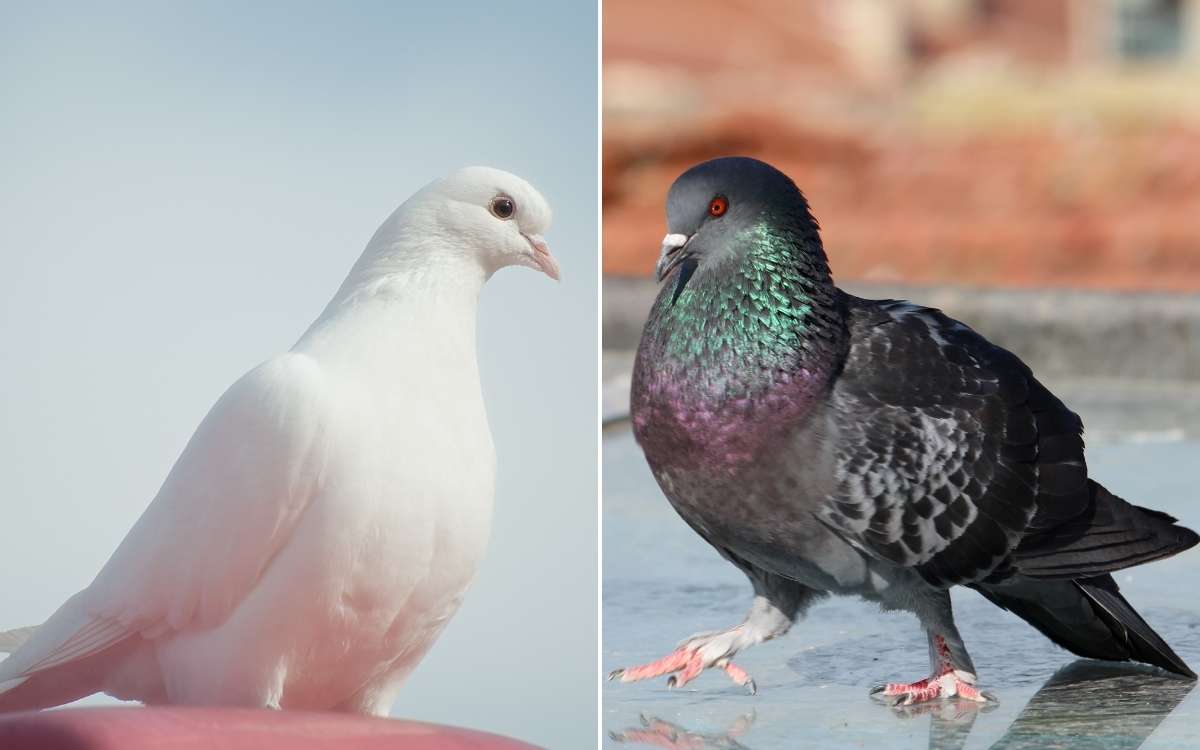
Image Credit: nepigeonsupplies
And, if you don’t believe this visual, let’s compare the average size and weight of these birds!
| Adult Pigeon | Adult Dove | |
| Length | 32 cm to 35 cm | 26 cm to 31 cm |
| Weight | 250g to 350g | 96g to 170g |
Another feature to notice is that doves have a slender and longer beak. Their eyes are also slightly bigger than pigeons.
What’s more, their tails are longer, thinner, and more expressive than a pigeon’s tail. The best way to observe this difference is when a pigeon and a dove are in flight. While the dove’s tail will fan out more, the pigeon’s tail won’t.
As far as colors go, the species of pigeons and doves come in a variety of colors. You will find white, grey, brown, blue, purple, and many other colors.
However, the majority of doves lack a patterned body. They will have some specks and spots on their feathers but they won’t be filled with them – like a feral pigeon would be.
2. Speed
Pigeons are known to be better flyers than doves. They have excellent homing abilities, which means they can navigate journeys of hundreds of miles perfectly. This is one of the reasons why they were used as messengers.
People would send pigeons across cities and even countries. These birds made it most of the time due to their powerful flying abilities and sense of smell.
Moreover, pigeons are also faster than doves. They have been traditionally used as a racing sport because when trained well, they can fly faster than hawks and falcons.
The average pigeon flies at 70mph, whereas a racing pigeon flies at 93mph (which is roughly 150 km per hour!)
Comparatively, doves have an average speed of 30 to 55mph. This is much slower than the majority of pigeons.
However, doves are better at navigating through tight spaces and dense vegetation. Their slender bodies and shorter wingspan allow them to switch directions faster. They often make out of tight spaces without having to slow down at all.
3. Sound
Both doves and pigeons make a cooing sound. However, the reason why both of them coo and the type of coo they produce is different.
Usually, a pigeon will make a deeper and louder cooing sound to communicate. When finding a mate or courting, their coo will be softer. But when a pigeon comes across a predator, it will grunt to warn others.
Baby pigeons may hiss if a predator tries to come near them. At other times, the babies will squeak and whistle to get their parent’s attention.
Comparatively, doves always produce a softer and longer cooing sound. During the mating season, the unpaired males sing a special song where a soft coo-oo sound is followed by 2 or 3 loud coos.
But, if a male is paired and building a nest, it will make a 3-part coo-OO-oo call, with the middle being the loudest. The bird will keep cooing until the nest is built and ready to be used. Females will sometimes produce the soft Ohr-Ohr sound when sitting in the nest.
Other than this, a dove will loudly whistle when taking off or landing. This startles the predators and warns other doves about any nearby dangers. However, a pigeon makes no noise when taking off or landing. It will just flap its wings noisily.
4. Mortality
Pigeons have a longer lifespan than doves in the wild. While a pigeon can easily survive an average of 5 years, a dove hardly lives for 1.5 years.
Only 40% of doves live more than 1.5 years in the wild. And from this 40%, only 10% make it to 5 years (which is their average lifespan).
This is primarily because doves are weaker and slower than pigeons. These birds can’t fly well and are an easy target for several predators.
Pigeons are typically threatened by hawks, falcons, and other high-diving birds. But most doves also face danger from land predators, like snakes and rats.
However, if doves are kept in captivity, they outlast pigeons. The average lifespan of doves in captivity is 19 years, whereas the average lifespan of pigeons in captivity is 15 years!
5. Behavior
Both pigeons and doves can exhibit a different behavior, depending on their subspecies and location.
They are generally sweet and friendly birds who won’t shy away from approaching beings. However, they will display aggressive territorial behaviors during the breeding season.
These birds won’t let any small or big birds near their babies. Males will specifically participate in getting rid of intruders and potential threats.
However, one major difference between a pigeon’s and a dove’s behavior is monogamy. While pigeons mate for life, doves may or may not be monogamous.
Some species of dove will pair with one mate, and some will find a new mate in each breeding season.
Another difference is that some doves (like the common ground dove) will make a nest on the ground or low-lying land. Meanwhile, all pigeons prefer to nest on high, flat surfaces.
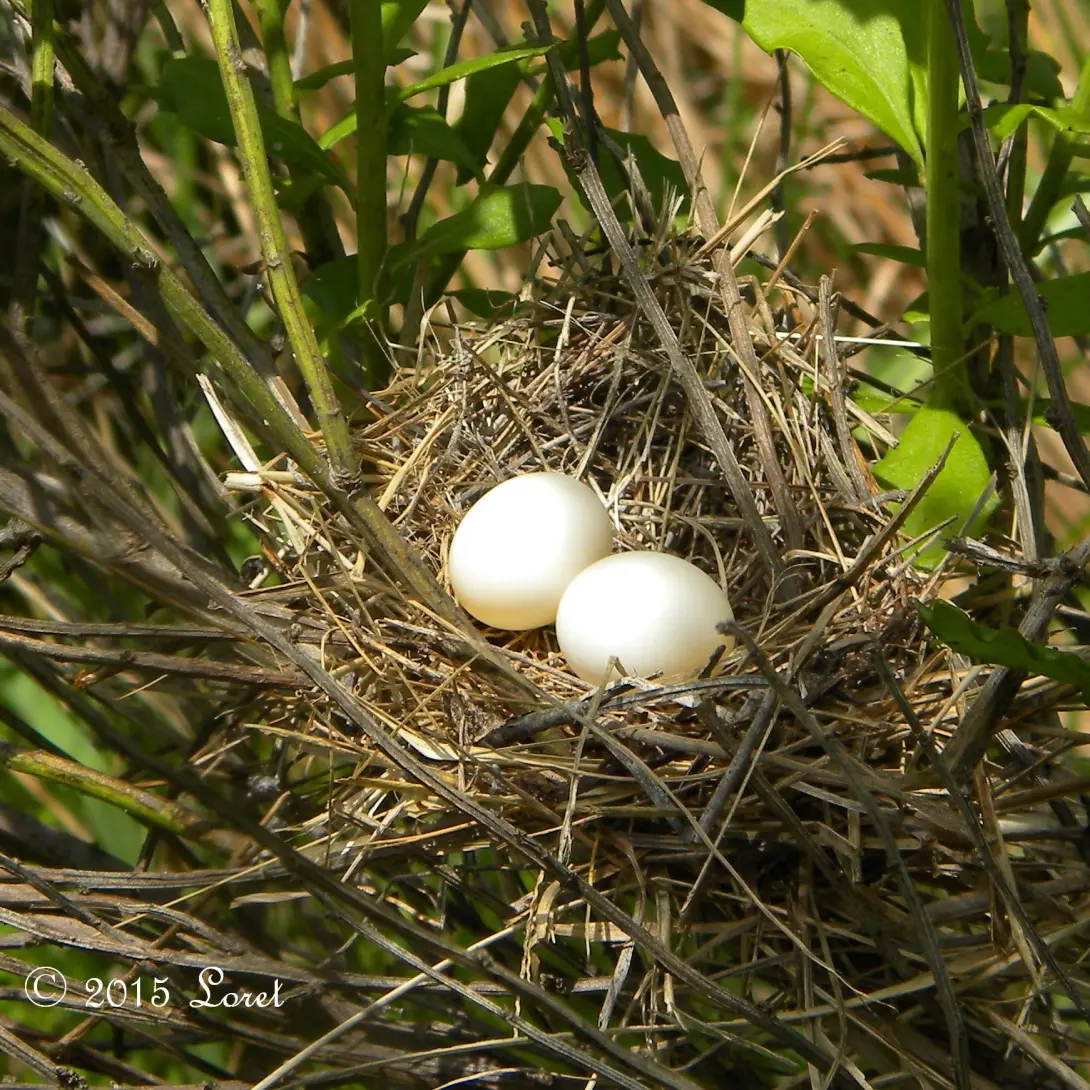
Image Credit: centralfloridacritteroftheday
Common Ground Dove’s Nest in the grass
So, Are Pigeons and Doves the Same?
No, pigeons and doves are not the same. They belong to the one-bird family Columbidae and have similar looks, but this doesn’t mean they are the same. Both have unique characteristics that shouldn’t be ignored.
It’s just like leopards and jaguars. Both of these wild cats have a similar appearance and share the same family (Felidae). But does that make them the same? No!
So, when you find someone calling pigeons and doves the same, remind them of these 7 major differences:
- Pigeons are bigger and bulkier than doves.
- Doves have thinner tails and larger eyes than pigeons.
- Pigeons are faster than doves.
- Both of these birds make different cooing sounds at different times.
- Pigeons survive longer in the wild but shorter in captivity. It’s the opposite for doves!
- Pigeons are monogamous, whereas doves can be both; monogamous and non-monogamous.
- Doves may sometimes build their nest on the grounds, whereas pigeons always choose a high spot.
Do you know more about these differences? Comment below, and we’ll add them to our list!
